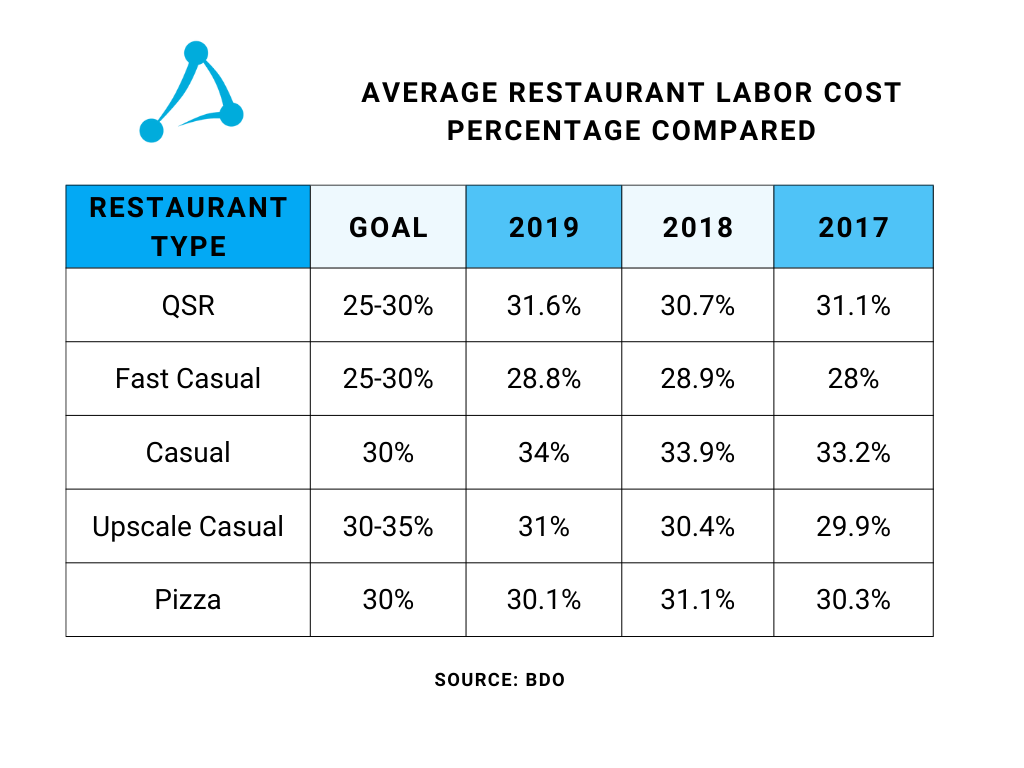How to Calculate and Control Your Restaurant’s Labor Costs
Restaurant
According to the National Restaurant Association, 89% of restaurant operators surveyed at the end of 2022 said that labor costs are a significant challenge. Labor is one of the biggest expenses for any restaurant, but with rising minimum wages and costs and a restaurant labor shortage, understanding and controlling labor costs is now more important than ever.
In this article, we’ll explain what restaurant labor costs are and why they matter, how to calculate your labor cost percentage, how that percentage compares to the averages in different restaurant types, and then give 5 main strategies you can reduce your labor costs… without needing to fire anybody.
What are restaurant labor costs?
In short, labor costs describe the total amount your restaurant spends on labor, including salaried and hourly worker pay, taxes, and employee benefits. It’s important to keep in mind that labor costs are more than just wages – they also include bonuses, overtime, payroll taxes, healthcare, and sick and vacation days. Anything that is labor-related goes into your calculations of labor cost.
Labor costs are one of the key variable costs of a restaurant, which refer to expenses that fluctuate based on the level of business activity (most notably food and beverage supplies, utilities, and wages). Fixed costs, on the other hand, are expenses that remain constant regardless of how much business the restaurant is doing. These costs include rent, insurance, and equipment purchases or leases.
Most employees in the restaurant sector are classified as non-exempt, are entitled to minimum wage rates and overtime, and fall under your variable costs. However, salaried employees would be considered a fixed cost – but both roll up into your labor costs.
If you saw our article on prime cost, you’ll also remember that labor cost is one of the two main components for calculating that metric, which is essential for analyzing the efficiency of your restaurant’s operations. Prime cost is made up of labor cost and the total cost of goods sold (COGS) and represents the controllable costs of a restaurant. Lowering prime costs can directly add profit to your bottom line.
How to calculate your restaurant’s labor cost and percentage
To calculate your restaurant’s labor cost, simply add up the categories of your labor-related costs. However, this number alone doesn’t tell you much. Rather, we want to calculate labor cost as a percentage. There are a few ways to do this but the most common is labor cost as a percentage of sales.
How to calculate labor cost percentage of sales
Labor cost percentage is straightforward to determine. You calculate it by dividing all labor-related costs by your gross sales in a given time period, then multiplying that result by 100.
To get a more accurate and comprehensive picture of this calculation, it is essential to consider the different costs and factors involved. Labor costs include not only wages and salaries but also benefits like healthcare, insurance, and retirement plans. Some indirect costs, such as payroll taxes, workers' compensation, and paid time off, should also be factored in.
First, add up all your labor-related costs to determine your overall labor cost. Then, determine your sales/revenue – you should already have this number in your books and/or POS software.
Now divide your restaurant’s labor cost by annual revenue. For example, let’s say you paid $660,000 a year in labor costs and brought in $2,200,000 a year in sales. Divide $6600,000 by $2,200,000 and you’ll get 0.3.
Multiply this by 100 to get the labor cost percentage: 30%.
Now once you’ve calculated your labor cost percentage, how do you know if you’re doing well or if there’s a problem? You need a benchmark to make sense of your calculation.
Average and ideal labor cost percentage for restaurants
Like other costs, labor costs can vary based on a variety of factors, including type of restaurant and location. Luxury restaurants will have higher labor costs than fast casual or QSRs. State minimum wage differentials and differences in top credit allowances towards minimum wage will affect labor cost percentages even for the same chain. Multi-location operators should note that since the size, location, and performance of each store differs, it's not uncommon for labor cost percentages to vary within a franchise.
Generally, a good labor cost percentage for a restaurant is between 29% and 33%. But that’s not good for everyone – different types of restaurants will want to aim for more niche-specific benchmarks. Here’s some data from accounting firm BDO with average and ideal restaurant cost percentages across the main restaurant types:
 QSRs and fast casuals can serve customers faster and can usually get by with a dozen or less employees even at their busiest, so their labor cost percentages will be lower. Notice they are below 30%, so for owners and operators of these types of restaurants, you should be aiming lower. Full-service restaurants, on the other hand, will usually have a higher labor cost percentage. While fine dining restaurants will typically have higher labor costs, this should also be partly offset by higher ticket prices.
QSRs and fast casuals can serve customers faster and can usually get by with a dozen or less employees even at their busiest, so their labor cost percentages will be lower. Notice they are below 30%, so for owners and operators of these types of restaurants, you should be aiming lower. Full-service restaurants, on the other hand, will usually have a higher labor cost percentage. While fine dining restaurants will typically have higher labor costs, this should also be partly offset by higher ticket prices.
Labor cost percentage over time
It’s worth pointing out that calculating restaurant labor cost percentage is not a one-time task. It should be done regularly, preferably weekly or monthly, to stay on top of any fluctuations in sales or labor costs (just like we talked about with prime costs). By monitoring labor costs as a percentage of sales, restaurant owners and managers can identify potential problem areas and take corrective action before they become entrenched issues.
Comparing labor cost percentages across different periods or locations can also help management identify trends and best practices. For example, if one restaurant has a consistently higher labor cost percentage than its peers, it may be a sign of poor scheduling or inefficient processes that need to be addressed.
5 ways to reduce labor costs (without firing anyone)
Focus on staff retention
The hospitality industry is known for high employee turnover rates, with one study finding turnover rates in hospitality (including restaurants) to be as high as 74.9%. Since the COVID-19 pandemic, staffing has only become an even greater challenge, with restaurant quit rates hitting all-time highs in 2021 (and higher than any other industry). In 2023, 62% of restaurants still don’t have enough staff to meet existing demand.
One of the most important ways of reducing your labor cost percentage is to keep the employees you have. Losing a front-line employee can cost an employer nearly $6,000, which equates to as much as $150,000 per year lost due to employee turnover. Due to the nature of the restaurant workforce, some factors which cause high turnover are unavoidable: young people working before going back to school or other training, limited schedules due to academic or other commitments, seasonality, and more.
However, there are some important factors you do control as an operator which can improve employee retention:
Compensation. While offering competitive compensation and benefits packages may seem counterintuitive to lowering labor costs, it can pay off when you take into account the greater cost of hiring and retraining. This includes paying staff above the minimum wage, providing health insurance, and offering paid time off. Research has shown that employees are more likely to stay in a job when their compensation aligns with industry standards and when they have access to healthcare and time off for personal reasons. Additionally, offering bonuses based on performance and providing opportunities for promotion can help motivate staff to stay with the company.
Positive work environment. Another way to retain staff is by creating a positive work environment that prioritizes employee well-being. This includes providing regular training support, and professional development opportunities. Employees who feel valued and supported in their role are more likely to stay with a company long-term. Additionally, acknowledging and rewarding hard work and dedication can help foster a sense of community and belonging amongst staff, which can lead to increased job satisfaction and retention.
Open communication. Part of keeping a positive work environment is keeping communication open with your staff and encouraging them to bring problems to you. This can involve a cultural shift if it isn’t something you’ve been practicing. Regular one-on-one meetings with managers can help build greater trust, communication, and employee loyalty.
Avoid overtime for hourly staff
You already know it, but it’s worth re-emphasizing: avoid overtime pay to reduce your labor costs! Many states require employers to pay time-and-a-half or even double-time to employees who work over 40 hours in a workweek. Spread your staff evenly, making sure they’re scheduled below that 40-hour threshold. Ideally, hire enough employees to avoid needing existing staff to work over – which is a lot easier said than done these days!
Also, keep track of many hours employees have actually worked as opposed to just what they’re scheduled for. Your labor management software may have a feature that does this automatically.
Plan your schedule ahead of time
This goes hand-in-hand with the previous tip; to avoid overtime, you’ll need to plan your employees’ schedules in advance. This will also help give them more predictability, which will lead to greater satisfaction and help to reduce staff turnover (see, everything works together!).
Both overstaffing and understaffing cause problems: overstaffing leads to unnecessary costs, while understaffing can lead to poor service quality and unhappy customers. Although you’re less likely to be voluntarily understaffed in current conditions, if you do have the option, don’t cut schedules too much just to reduce labor costs. Labor costs are only one part of the puzzle, and customer satisfaction is important. If you’re close to the recommended range above, you probably don’t need to cut too much more.
A well-planned schedule can also avoid needing to bring in extra staff, call in last-minute replacements, and minimize “on-call” shifts, which can require compensation even when an employee is not called in. Scheduling willing employees for split shifts can help ensure coverage. While some jurisdictions have regulations that require extra compensation for employees on split shifts, they can help save labor costs over time.
Also, ensure that employees are paid for when they are scheduled for, not for whenever they clock in. Many POS systems or employee scheduling software tools will have clock-in reinforcement features which mandate that employees clock in within certain time windows.
Cross train employees
Employee training can often fall by the wayside in a busy restaurant environment, especially when you don’t know how long that employee is going to stick around. But cross-training employees in different responsibilities and duties can give you greater flexibility in scheduling, making it easier to schedule additional employees or find replacements for shift swaps. When employees can fill in gaps, you can avoid having to schedule someone at the last minute because they’re the only one who can perform a certain task.
Also, cross-training can help improve employee morale, give them a sense of ownership, and make their job more interesting as they learn new things. And as many restaurants struggle with a labor shortage, this type of cross-training is becoming more of a necessity to ensure all necessary tasks can be completed.
Leverage technology
Technology can help you reduce labor costs in two main ways. First, there are a range of efficiency-improving technologies that can help free up your existing staff and reduce your reliance on hiring more. These include self-ordering kiosks for QSRs or tableside ordering and contactless payments for full-service restaurants on the front end, or new restaurant technologies such as robots that automate certain tasks in the back of house.
The second main way is by using software to help manage your workforce, save administrative time, and make better decisions. This can include workforce and labor management software, POS systems with extra features, and a variety of other software tools.
Agilence Analytics for restaurants is one such tool for multi-chain restaurant operators, managers, and their corporate offices. Agilence provides an analytics solution which integrates with a broad set of data sources, including POS systems, inventory, alarm, store, HR, IoT, and other business applications to provide a comprehensive view of your business operations. Agilence can be used to improve margins in a variety of ways, from reducing shrink to improving labor productivity.
You can reduce labor costs with Agilence by:
- Comparing employee performance metrics to identify high and underperformers
- Detect employee fraud and theft to increase profits
- Understand online sales and ordering fulfillment to increase margins
- Revising hiring and training practices to minimize turn-over costs
- Analyzing sales by day, channel, and daypart to optimize scheduling
Learn more about Agilence restaurant analytics here.
Related Articles

5 Ways to Reduce Restaurant Labor Costs
In the restaurant industry, serving great food is only one ingredient in the secret sauce for success. Great food may increas...
How to Calculate and Control Restaurant Food Cost: Comprehensive Guide
When it comes to ensuring profitability for your restaurants, cost control is essential to hitting your margins. In 2023, eve...
How Restaurants Can Thrive During the Labor Shortage
Great employees are the core of any restaurant’s success. Technological advances can’t replace the human element of warm cust...Subscribe to our blog
Receive free educational resources like exclusive reports, webinars, and industry thought leadership articles straight to your inbox.

